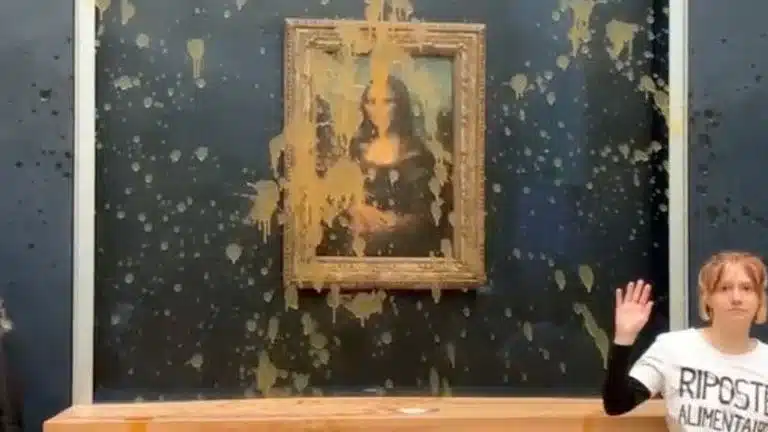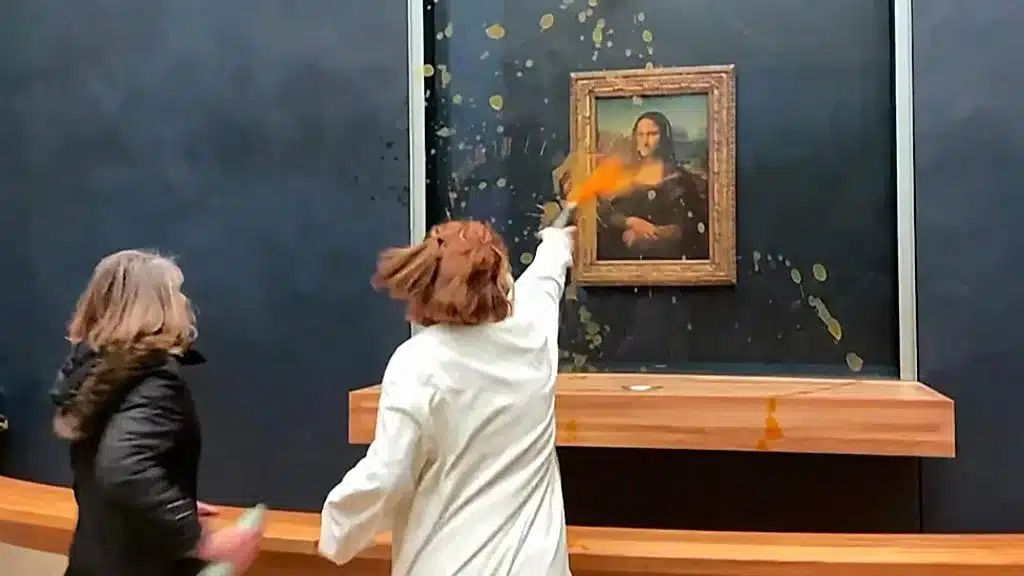Environmental Activists Throw Soup at Mona Lisa in Paris

The Louvre’s serene halls witnessed a startling spectacle on Thursday as two environmental protesters hurled a can of soup at Mona Lisa. While the beloved masterpiece, protected by bulletproof glass, emerged unscathed, the incident sparked a global debate about climate action, the boundaries of protest, activism, and the pressing issue of sustainable food systems.
(Also read Six Nations 2024: Fixtures, Squads, Tickets & More.)
The video footage by CL Press, a French news agency, shared widely on social media, captured the jarring moment. In this video, one woman is seen approaching the painting, her face resolute, before unleashing the orange liquid onto the bulletproof glass. Beneath the shield, the Mona Lisa–possibly the most recognized grin in the world–remained calmly unaltered.
While seemingly bizarre, the act was not merely a random act of vandalism. It was a meticulously orchestrated performance. The protesters, identified as members of the French Group Riposte Alimentaire (Food Response), donned T-shirts emblazoned with their slogan. Their message, delivered in a defiant chant, resonated through the hushed gallery: Which is more important? The right to healthful, sustainably produced food or the right to art?
“Your agricultural system is sick,” they declared, their voices amplified by the stunned silence. “Our farmers are dying at work.” Riposte Alimentaire, part of the broader A22 movement alongside groups like Just Stop Oil and Extinction Rebellion, sought to draw attention to the urgent need for sustainable agriculture and food security. The scene that unfolded was one of controlled chaos. Gallery staff scrambled to shield the Mona Lisa with black cloth, their efforts partially thwarted by the sheer audacity of the act.

Their audacious act, while met with shock and disapproval by some, ignited a crucial conversation about the methods and ethics of protest, particularly in the realm of art preservation.
The Mona Lisa, arguably the world’s most recognizable artwork, has faced similar food-based attacks before. The painting was shielded from view in 2022 when a man dressed like an old lady smeared custard pie on the window. Similar incidents have targeted other renowned works, from Vermeer’s “Girl with a Pearl Earring” to Van Gogh’s “Sunflowers,” highlighting the vulnerability of cultural heritage to the growing wave of climate and environmental activism.
Throwing Soup at Mona Lisa spaked a debate around the World
While some may condemn the act as disrespectful and damaging to cultural heritage, others see it as a desperate cry for attention in a world seemingly deaf to the impending climate catastrophe. As Riposte Alimentaire stated on their website, “Art shouldn’t be silent when humanity is dying. We use art to wake up consciences and demand action.”
The message of Riposte Alimentaire is indisputable, regardless of one’s opinion of the methodology. Our planet’s future and its inhabitants’ health hangs precariously in the balance.
Ultimately, the incident at the Louvre leaves us with more questions than answers. Was throwing soup at the Mona Lisa a justified act of protest or a misguided attempt at garnering attention? Should art be a sacred space, immune to the clamour of societal issues, or should it serve as a canvas for reflecting the anxieties and struggles of our times?
These questions will undoubtedly continue to be debated in the wake of this incident. However, one thing remains clear: Despite the stains of soup at Mona Lisa, its protective glass continues to hold a mirror to our world, forcing us to confront uncomfortable truths and sparking crucial conversations about the future of our planet and the role of art in it.
LATEST NEWS
DISCOVER MORE





